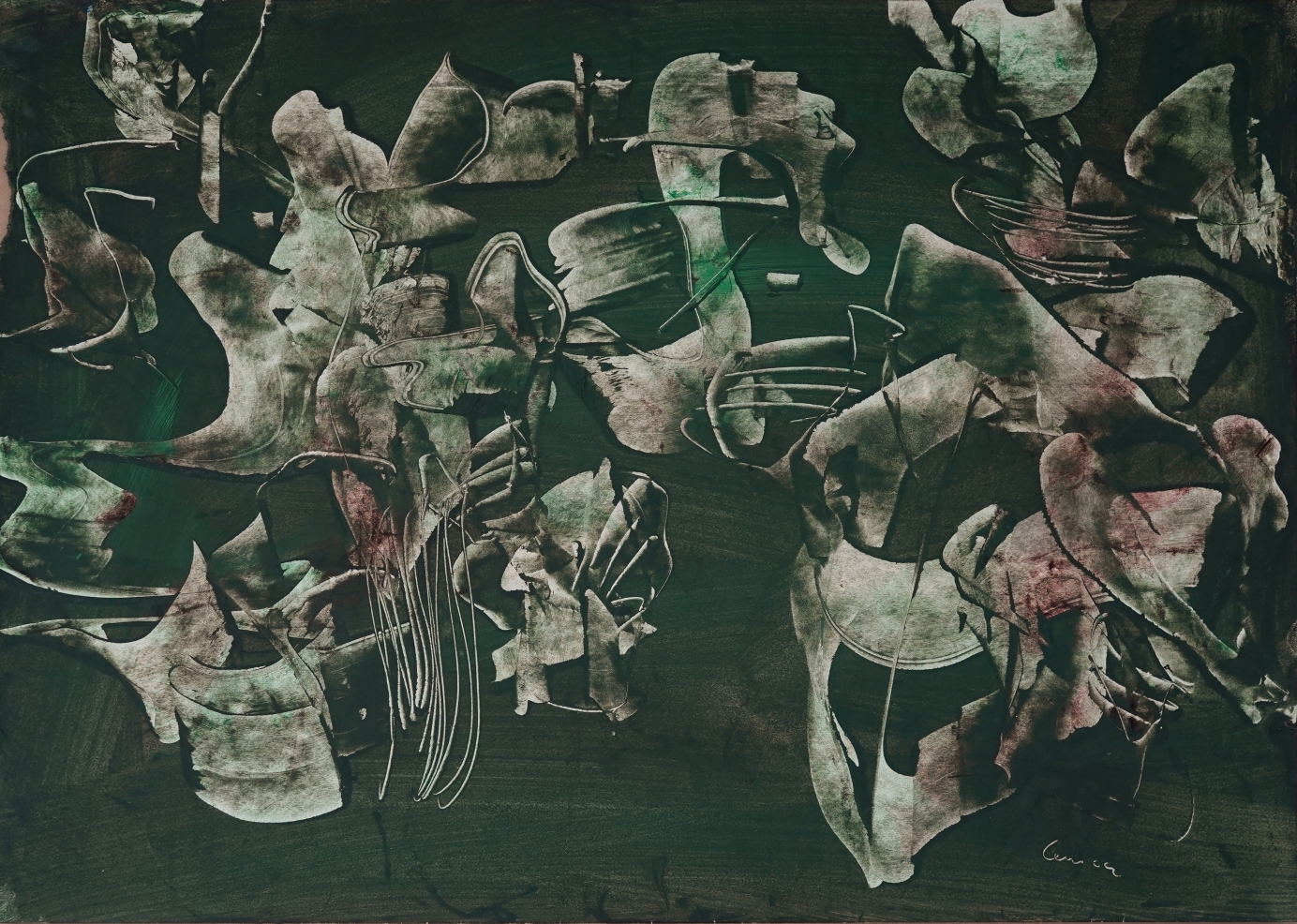Alfred Lenica
Silence in Space
22.04-31.05.2023
The exhibition Silence in Space, curated by Paweł Bień, presents sixteen works by Alfred Lenica. The selection opens with an untitled gouache from the 1940s, while it concludes with three works representing the period when Lenica achieved his full artistic potential in the mid-1940s, i.e. the way towards the achievement of the iconic formula of ‘surrealist abstraction’, thus securing Alfred Lenica’s place among the most important Polish artists of the 20th century. Although mainly associated with painting – Lenica also remained, throughout his creative path, a musician. It is the very aspect of the artist’s ever-present musicality in the artist’s paintings that the curator directs the attention of the audience.
Alfred Lenica in 1924 in Poznań graduated from the Music Conversatory in the violin class, and a year later he studied at the Private Institute of Fine Arts with A. Hanytkiewicz and J. Kubowicz.
During the Second World War, the artist, his wife and son were displaced from Poznań and taken in freight cars to Mielec. Thanks to his musical education, Lenica was able to provide his family with basic living conditions – he found employment in one of the live music venues.
However, he did not give concerts alone; he was accompanied by a young pianist, Jerzy Kujawski. Between one number and the next, the men got into discussions, through which they learnt that they were connected not only to the fate of the restaurant’s musicians, but also their love of painting and, in particular, of Surrealism.
Between 1947 and 1949, Alfred Lenica, together with Feliks Maria Nowowiejski and Idefons Houwalt he founded the 4F+R group (form, paint, texture, fantasy + realism). According to the artist and the painters he befriended painters who were friends with him, this was a formula for creating good art. The meaning of the letters used in the group’s name is explained by
statement by Feliks Maria Nowowiejski:
The paint does not cease to be – in Tascism – an instrumental shaping force. The texture, the preservation of technical traces of the painter’s work, the attempts to draw with new tools and to draw new materials into the orbit of sculpture, are staying in place. And also fantasy, surrealist, exploiting new possibilities”. How do we understand +R ‘Group Realism? There has been a growing belief that an image is realistic even as soon as it is created as a utilitarian object, or encouraging a concept of an off-easel vitalism.
The formal result of the group’s theoretical conceptions is the painting Paints in Motion, which opens the exhibition, painted in the landmark year of 1949. Some researchers regard it as the first Polish Tascist painting, while the more cautious write cautiously of ‘quasi-prototascism’. Soon, the palm of precedence will be snatched from his hand by Tadeusz Kantor and this version of events will be reproduced in many following publications.
Paweł Bień, the curator of the exhibition, writes in an accompanying publication:
“For me, the key to Lenica turned out to be the music, because even if we are talking about The Silence of Space, we can understand it as a pause separating successive musical phrases. I don’t know if it is possible to ‘truly know the artist’, but it is certainly possible to hear some of the images.”
The musical predilections of the author become apparent everywhere. Sometimes it is the capricious changeability of the rhythms, at other times an impressive spectrum of the variety of traces of the painterly gesture; “tonal exercises” are juxtaposed with works of fantastic colour “intonation”, and finally – a surrealistic surrealist sense of humour and the paraphrasing of cultural traditions in collages, combining, as is customary with the as he usually does, combining seemingly contradictory elements, i.e. press photography and mature abstract painting. The colours of his paintings are based on consonant harmonies or, on the contrary – the use of dissonant consonances, which opens the way to the second category of musical inclinations which are apparent in Lenica’s paintings. The second level is no longer the author’s linguistic message, but the visual solutions applied by the painter, evoking associations with the arrangement of sound. The notion of tempo seems particularly appropriate here. As a violinist, he certainly did not need to be told about the importance of bowing, how the sound is born from the correct positioning of the finger on the string. The trace of a hand left on
painter’s canvases or papers builds up multi-directional tensions, evokes movement, creates polyphonic structures. The artist has often stressed that his main aspiration is to find expression in painting for experiences and emotions that are most elusive and difficult to define. He saw a similarity between painting and music, which was also his lifelong passion.
Exhibition cataloque
Works
| Status | Title | Year | Technique | Dimensions | |
|---|---|---|---|---|---|
| Loading… |

|
Poszukiwanie 26 | 1961 | gouache on paper | 59.3 x 41.8 cm |
| Loading… |

|
Poszukiwanie 36 | 1962 | gouache on paper | 41.7 x 59 cm |
| Loading… |

|
Nowy środek 52 | 1961 | gouache on paper | 41.5 x 52 cm |
| Loading… |

|
Smugi 1 | 1954-57 | mixed media on paper | 60.7 x 42.8 cm |
| Loading… |

|
Smugi 21 | 1954 | mixed media on paper | 43 x 60.7 cm |
| Loading… |

|
Plamy 43 | 1957 | gouache on paper | 37.1 x 37.5 cm |


